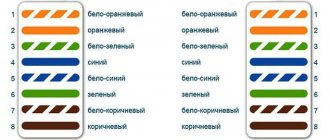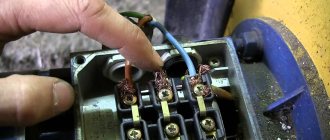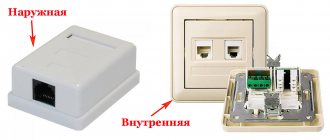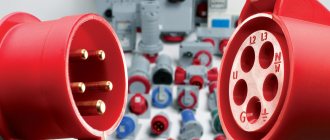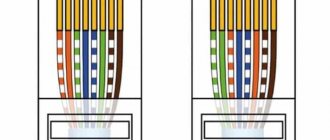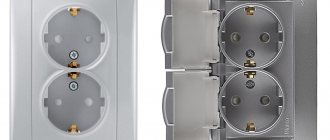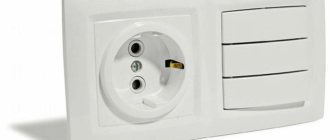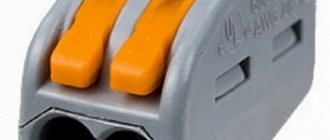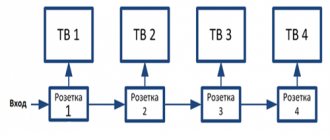During a major renovation of an apartment, electrical installation work is also carried out according to a pre-drawn diagram. As a rule, they include replacement of wiring, including electrical installation products. Among the various modifications of these devices, a triple socket installed in one socket box is in demand, providing the connection of several units of household appliances in one area at once. Often, replacing single sockets is done outside of general repairs and can easily be done on your own.
How to replace the socket box without ruining the wallpaper?
Accordingly, in this case, there is no need to tear off the wallpaper, unroll it, then re-glue it, grease it - spoil the newly created interior. All this is nonsense and there are no unsolvable cases.
When you pull out the old socket, select a socket box that is as close in diameter as possible to the old hole - so that it fits as tightly as possible. And if there is any play left (very small), use foam double-sided tape. But remove the protective strip from the tape only on one side. Glue, wrapping around the entire circumference. So you will add this missing millimeter of diameter. And that’s it, it will fit tightly into the hole and most importantly it will not slip.
Because you won’t be able to guess which one will suit you in the end.
And an experienced master himself may not be able to guess by eye: even if one seems to initially fit, then during the final installation it may not fit properly. That’s why an electrician walks around with these several “spare” socket boxes.
It’s better to trust such things to people who specialize in this and do it on an ongoing basis, so as not to store a bunch of unnecessary construction rubbish later. As they later write on the Internet, “I’ll give away the remaining building materials.”
What can replace a pleasant and professional installation? - nothing! Therefore, do not save a penny on socket boxes and use good socket boxes.
Andrey Bely. REMONT-EKSPERT.RU
When using materials from AXIOMPLUS.COM.UA
All rights reserved. Copying is permitted only with reference to the source
Theoretical basis
The main thing to remember when carrying out any work with electrical appliances is safety precautions. Before connecting the wires to the outlet, be sure to turn off the electrical current. To do this, you need to turn off the corresponding switch located on the panel, or unscrew the plug from the meter. Then check the operation of the electrical network and voltage by trying to turn on the light.
In fact, the socket connection diagram is quite simple. Only two wires are used here - zero, phase. For sockets that provide grounding, you need to connect a third wire.
It is necessary to ensure the presence of reliable contact, as well as to exclude the possibility of a short circuit. To do this, protect that section of the wire that is located at the entrance to the terminal.
If there is an excessive stripped section of the wire, it must be cut using wire cutters to the required length. The exposed part of the wire is located exclusively inside the socket and should not protrude from the terminal.
At the next stage of work, you need to tighten the clamping screws well. Check that the wire is securely fastened in the terminal. The mechanical reliability of such a connection is very important. It is not permissible for the wire to fall out of the terminal even if force is applied.
By applying this theoretical knowledge, you will not have problems connecting sockets. If you doubt your abilities, it is recommended to watch video instructions on how to connect any type of outlet.
Wire routing
This triple socket installation step includes the following steps. First the cable is laid:
- The wires are connected based on a parallel circuit. The latter assumes that to each wire cord from the shield you can connect two additional ones, extending from the cores. They are connected to the second and third socket modules. You need to take an indicator screwdriver and use it to find the phase and zero.
- Turn off the power in the panel.
- Wire cords are twisted using contact tips designed for this purpose. The latter are inserted into socket clamps and screwed in place. Having completed the initial twisting, the wire cord is connected to the second outlet. It is passed through the opening in the rear panel of the socket box. The same is repeated with the third hole.
Triple socket - economical option
Triple socket with grounding
No electrician in his right mind would advise you to install such triple sockets on a permanent basis. They can serve normally as a carrying extension, but nothing more. However, on the market you can often find products from Kuntsevo Electro and similar companies that offer you 3 sockets at once for a price of less than $4.
Advantages of this solution:
- They take up less space than the options described above - three sockets fit into a 95*95cm block;
- Price. The mechanism of a normal Legrand socket costs $4, but here, together with the housing, the price is the same for three pieces.
Here are the disadvantages:
- Due to its design, the socket cannot be properly attached to one standard socket box and will constantly fall out of it. No matter how carefully you use it, it will definitely fall out!
- The quality of the plastic used. Self-respecting companies do not produce sockets of this format, and all the others, including Kuntsevo Electro, use cheap flammable plastic, so the use of such sockets even as “makeshift” is very dangerous.
- Contacts. There is no copper, bronze or brass inside these sockets. Only painted tin. This is how cheap goods are made. After watching a video about the production of sockets in Kuntsevo and even disassembling such a socket, you will see supposedly brass in the contact groups, but everything immediately falls into place if you check this “brass” with a magnet. After some time, tin contacts stop springing, transfer electricity through the plug worse, heat up, and rust. In general, they do everything that a tin should do in unusual circumstances.
Do not install such sockets unless absolutely necessary for yourself or the customer. In both cases it will cost you more.
Comments:
I installed a triple socket like the one in the last picture and warned customers that it would not last long. As a result, after 2 weeks they called me again and I inserted a single normal socket into their broken-down socket. It’s better to have one with a remote tee connected than a triple one in one glass.
Explain to me why they use a level when installing a socket block? What is the need for this? Isn't it enough to simply focus on the floor or other surface? On the edge of the baseboard, for example.?
Sasha, that's what I usually do. If the floors are not level and the sockets are set to the horizon, then the customer will see that you installed the socket crookedly. Therefore, it is better to rely on the actual floor, and even better on the baseboard
I installed triple Turkish Vi-ko sockets with a bar on the reverse side of the old Soviet sockets (they fit perfectly) so that the socket would not bend due to hooks. They have been working for 17 years. Nothing hangs loose or falls out. I connect a vacuum cleaner, computer, laptop, phone chargers, etc. Everything is fine.
Leave a comment Cancel reply
Fuel-free generator - a way to make money on illiteracy
Pros and cons of vertical wind generators, their types and features
Windmill for a private home - a toy or a real alternative
Power bank with solar battery - calculation for illiteracy
How to choose a solar panel - overview of important parameters
Source
When there is no socket at all
Rarely, but it also happens - the socket dangles, and when you take it apart, it turns out that it simply rests with spacer tendrils against the wall, preferably a concrete one.
There is only one correct solution to the problem - to install a socket box, since the steel tendrils will eventually crumble even the most durable concrete and the socket will fall out.
If there is no other choice but to fix the socket in the wall (there is no socket box and nowhere to buy one), then you can make a homemade mount for the socket. To do this, you will need to make chopsticks: from thick linoleum, sandpaper or a couple of pieces of wooden board - preferably not overdried, so as not to crack when tightening the fastening bolts.
- You need to try on where the spacer antennae rest against the wall and carefully hollow out small recesses there.
- Choppers are cut to fit the size of the resulting pits. If it is linoleum or sandpaper, then it is advisable to fold them in half, with the smooth side inward, so that the rough side touches the wall and the fastening antennae. The tree is simply given the desired shape - unlike classic chopsticks, which are made cylindrical, these need to be made rectangular.
- Next, the choppers are inserted into the fastenings, a socket is connected to them and the bolts are tightened, which pushes the fastening antennae apart.
This method can be effective even for walls not made of the hardest material, such as adobe brick, but if possible it is still recommended to make the correct fastening using socket boxes.
Removing the keys: how to remove the switch for wallpapering
To remove the wallpaper switch, you will need tools.
Namely
- Screwdriver – plus and minus;
- Indicator screwdriver;
- Portable lighting device.
Using a negative screwdriver, you need to remove the switch keys, for which you need to install its tip between the frame and one of the keys, above or below. With a little effort and using a screwdriver as a lever, you need to pry up the key and help with your hand to pull it out of the grooves. The second key can be removed freely. Using an indicator screwdriver, you need to make sure that there is no electrical voltage; to do this, it must be applied to each of the electrical contacts. If the switch is located in a dark place, you should use a flashlight or other portable light source so as not to damage the switch and special equipment.
They check the integrity of the electrical contacts and the presence of electrical voltage on them, after which they make a conclusion about whether the device is in working condition. When there is a need to dismantle the switch, for a more detailed inspection with disconnection from the power supply, or there is 100% confidence that the device needs to be replaced, then you should remove not only the keys, but also the retaining frame, which in turn holds the decorative frame. To do this, you need the same set of tools, but if the switch is attached using Phillips bolts, then in addition you will need to use a positive screwdriver.
The locking frame is located immediately below the keys, and can be removed using a minus screwdriver. It is attached to latches, they are present on the switch body, so you need to pry the teeth with a screwdriver and pull it towards you by hand. Once you have managed to open and remove it, you can begin decorating the room. After gluing, you need to assemble the switch. Assembly is carried out in reverse order.
Diameter of the socket box, its dimensions, installation features
If an apartment or house is being renovated, it is often necessary to install new sockets, change switches and even electrical wiring. In the case of walls made of concrete or brick, this can be difficult to do.
It is important to correctly determine the diameter of the socket box, its size, and select the necessary tools
Among the things that may be required is a special crown for processing the concrete surface. Such equipment is also suitable for drilling brick walls, concrete with additional reinforcement, stone, natural and artificial. A high-quality crown penetrates the structure of the material to an impressive distance - up to one and a half meters.
Important! It is better to avoid standard drills intended for processing metal and wood. They are not suitable, as in such conditions they quickly become unusable
Determining the diameter
If a triple socket is installed in one socket box, it is important to correctly determine the diameter. These indicators are determined by the size of the crown, as well as other factors:
- The design of the equipment is the diameter of the socket box and its dimensions. Knowing these characteristics, you can safely go shopping for the right crown;
- To avoid mistakes, it is advisable to check for which socket boxes a particular crown is suitable;
- If we are talking about standard concrete sockets, their sizes may vary, but the diameter is 68 millimeters. All modern sockets and other similar equipment correspond exactly to them. Thus, you can safely choose 68 mm crowns for drilling;
- Equipment with a diameter of 70-75 millimeters are used much less frequently.
Where to begin
Before you begin, you should assemble the crown, doing it carefully and carefully - first fix the drill itself using bolts, then fix the threaded bowl. Among the main requirements for assembly are density and absence of inconsistencies. Neglecting these recommendations can lead to deformation of the bowl or even the drilling element. In the worst case scenario, the person doing the work could be seriously injured.
Then you can begin the drilling process using a hammer drill. An alternative to a hammer drill can be an impact drill. A regular drill will not work. You should first apply markings that will be easy to navigate. In addition, for each piece of equipment there are corresponding installation rules. Here are a number of standards that modern specialists try to adhere to in their work:
- In residential premises - about 30 cm from the floor. We are talking about the European standard, and the depth of the socket box is calculated in accordance with it
- Kitchen - about 100 cm from the countertop
- Bathroom with washing machine - about a meter from the surface of household appliances
- Pass-through type switches - about 90 cm from the floor line.
Important! The given standards are not strict rules. It's about recommendations
Hole Size Correction
It happens that the diameter of the concrete socket matches the same parameters of the crown perfectly. In the case of depth, discrepancies may be noted. However, this is easy to fix. All you need to do is adjust the depth so that the socket falls slightly into the hole - not too much, just a few millimeters. The reserve is needed so that not only the equipment itself, but also alabaster and another fixing solution can be placed in the hole.
After fixing the socket box, its protruding section is carefully cut off - thus, the element will be recessed to the required depth and will be flush with the concrete or brick wall. The design will look neat. To connect the wire to the electrical outlet, a groove is made - it should be located at the top. It can be easily done using a hammer drill or even an ordinary chisel - it depends on the characteristics of the material from which the wall is made
It is important that the wire is placed neatly. The socket is turned over, you need to find a slot on it into which the wire will be placed. The best option is to fix the wire at the back
Thus, it will be much easier to install the equipment. The wire is inserted into the socket box and in this form is placed in the previously prepared hole.
Important! The hole must have the reserve mentioned above. You may be interested in:
You may be interested in:
prokommunikacii.ru
Connecting sockets with a cable
The main nuance that causes heated debate among electricians is whether it is possible to connect an outlet with a cable?
And on this issue, many are divided into 3 camps: absolutely not
possible in some cases
you can always if the design of the socket allows it
Most modern sockets always have two terminals for each wire: phase-neutral-ground. Total 6 contacts.
It is assumed that in a walk-through socket all six ends of the wires (3 incoming + 3 outgoing) can be safely inserted into the terminals, clamped and be sure that everything is done correctly.
That is, phase and neutral working conductors are connected via a loop without problems, but for the grounding conductor, according to adherents of a categorical ban, this is unacceptable.
It is necessary to make a branch for it. Moreover, it is advisable to do it in a screwless manner so that there is no need for further maintenance (tightening). And this means sleeving by crimping, or soldering or welding.
The easiest and most convenient way to do this is by crimping. Add up the final cross-section of the three cores that will be connected by crimping and select the appropriate sleeve.
For example, you have a 3*2.5mm2 power cable. Incoming cable core 2.5mm2 + branch to socket 2.5mm2 + outgoing cable core to adjacent socket 2.5mm2. Total theoretically – 7.5mm2.
Due to the fact that the actual cross-section of the cores does not always correspond to the declared one, and loosening of the contacts is not acceptable here, select a sleeve with a slightly smaller cross-section than the calculated one - GML-6.
Place the vein into the sleeve and press the press with pliers.
Always cut off the excess length of the sleeve so that it does not take up free space in the socket box.
The resulting connection is best protected with heat-shrinkable tubing.
Although, of course, no one forbids applying several layers of high-quality electrical tape.
Especially if you have a powerful heat gun without smooth temperature control. With such a device, you can inadvertently melt certain parts of the socket box.
Power to the bottom comes from the top. If there is a break or violation of the grounding contact in the very first of them, then the “ground” will automatically disappear on the others. Which is categorically unacceptable.
However, many electricians are confident that the ban on such daisy chaining applies only to sockets located in different blocks, at a distance from each other. And this rule in no way applies to double sockets located in one block, united by a single frame.
That is, in fact, such a block is a kind of connector that has a single housing. This means that it can be considered as a single electrical installation product.
Most doubles, tees and even extensions are made in this way.
You will not be able to disassemble a single product without disconnecting the plugs from adjacent connectors. And since you have disconnected these plugs, then breaking the grounding conductor at the very first point will not affect anything.
But if the socket blocks are located far from each other and do not have a common body, then it is absolutely impossible to connect them with a cable.
Well, third interpreters of paragraph of the rules of the PUE 1.7.144 reasonably notice that in the PUE itself, nothing is said about the prohibition of “loops”. There is not even such a concept for sockets.
It says that the “Pe” conductor must be electrically continuous (the essence is in this word - electrically). And that the current-carrying elements of the device cannot be connected in series to the grounding conductor circuit.
There is neither one nor the other in the train. In most of these sockets, under one terminal, both conductors are immediately clamped. Moreover, in an acceptable way (screw or spring).
Now, if the socket had a ground input on one side and an output on the other (from under another independent contact), then yes - it’s impossible! Moreover, the PUE does not consider the socket contacts as open conductive parts, so clause 1.7.144 has nothing to do with it.
Even if you are forced to dismantle one of the looped sockets in this way, then in addition to the protective wire, you will also break the phase and neutral conductors.
Which of these opinions is true and how should you mount it?
If you are doing what is called for yourself and “for centuries”, so as not to look into the socket box for decades, then install a sleeve and make a branch, not a cable.
Well, if you are firmly convinced that the cable is not a violation at all, and it is not for nothing that manufacturers of sockets initially included the possibility of such a connection in their products, then at home you are free to act as supporters of the second and third methods.
In the end, this is your own home, and no one has the right to forbid you to do this and not otherwise.
Safety instructions
Connecting wires by soldering
When deciding to connect a built-in module, follow the safety requirements:
- Turn off the electricity and break the circuit.
- Use devices and tools with rubber or plastic insulation on the handles.
- Connect the wires with solder.
- Check the cable insulation and, if necessary, place it in a plastic tube.
- Cut the long strand or twist it into a ring and hide it in the wall.
- Extend a short wire, hiding the contacts.
- To prevent a short circuit, check that the socket and wire match the power and current in the circuit.
- Install the triple module in a wooden house only in a metal socket box.
- Place the module near the door so that the switch is closer to the opening than the socket.
Compliance with safety precautions will help to carry out installation work efficiently.
Wiring
- The insulation and conductors of the wires are checked for defects;
- The cover is removed from the distribution box;
- Different ends of the wires are inserted: on one side - into the junction box; on the other - to the installation room. In order to ensure convenience for new connections in the future, if necessary, the cable is inserted with a margin of up to 150 mm;
- Prepared at the top of the groove hole for the wire. To do this, use a chisel and a hammer or a hammer drill with an impact attachment installed on it.
- The wires are laid in a groove. At the same time, they should lie freely in the niches and not interfere with the socket box. On its reverse side there is a special slot for placing the wire;
- The cable can be fixed with alabaster or gypsum mortar, in increments of up to 250 millimeters;
- Defects are covered with putty.
Preparing and installing the outlet
Wiring
A triple surface socket installed outdoors poses a certain danger. After all, atmospheric influences on wires, cables or the outlet itself have an extremely negative effect.
Therefore, in order to avoid negative consequences, this should be taken into account during installation. Below we will provide only the basic rules for installing wiring, and more detailed instructions can be found in other sections of this site.
So:
- External wiring can be done in both open and hidden ways. However, the use of metal pipes is not allowed in all cases. To protect against the effects of precipitation, PVC corrugation or non-metallic boxes are used. At the same time, according to 2.1.63 PUE, installation must be carried out in such a way as to exclude the possibility of moisture accumulation.
- Overhead triple sockets and wires cannot be installed at a distance of less than 1 meter under the window and balcony. In addition, clause 2.1.75 of the PUE prohibits the installation of wires and cables closer than 0.75 m along the window and 1 m along the balcony.
- When installing inputs on insulators, the distance between the roof and the wire in accordance with clause 2.1.79 must be at least 20 cm. When connecting small building forms such as pavilions, temporary booths, etc. the distance from the input to the roof must be at least 0.5 m.
Socket installation
After you have completed all the preparatory activities and your triple surface socket is ready for installation, you need to decide on the type of surface on which it will be installed. If it is a combustible or difficult-to-burn surface, then before installation you need to install a lining made of non-combustible material.
This may be asbestos sheet or steel plate. If it is a fireproof surface, then additional gaskets are not needed.
So:
- If you are using a triple overhead socket, then first secure the box. This can be done using self-tapping screws. Some models have a special seal at the attachment points, which increases the moisture resistance of the outlet.
- The next step is to insert the cable into the outlet box. This is done through a special rubber seal, which is included in the socket. You simply make a hole in it large enough for the cable or wire to pass through and feed the conductors through it.
- Now you can cut the cable and go directly to the connection. If your electrical network meets the PUE standards, then you will have three wires connected to the outlet. One of them is phase, the second, blue, is neutral and the yellow-green wire has a protective function. We connect the neutral and phase wires to the power contacts. The protective conductor is connected to the corresponding terminal. Typically, all triple overhead sockets have the designation “PE” or a grounding sign for this input.
- Now we install the power part into the box on the appropriate fastenings and close it with a lid. That's it, our triple overhead socket is ready for use. After applying voltage to the power line of the outlet, you can check its functionality.
Connecting electrical points
Connection of socket boxes for triple sockets
The structure should be connected taking into account the wire cross-section. When installed externally, the ability of the wiring to withstand 3 consumers is checked. The presence of separate socket boxes provides for the laying of additional cables vertically or horizontally. After these works:
- Separate socket boxes are connected to the cable terminals and pressed using clamps.
- The ends of the conductors are twisted into the device.
- The central part is installed and the overhead cover is fixed.
When installing an outlet to an existing group, the machine is replaced.
If the socket box does not fit into the wall
In this case, the repair method is selected depending on what kind of electrical outlet is installed and what the wall is made of.
If the socket box was not “seated” on the mortar, then the size of the hole in the wall is “butt” and it needs to be expanded a little so that there is room to spread the plaster or cement mixture. Next, you need to inspect the socket itself - modern models have slots for threading the cable. They are located over the entire area, and if the putty is pressed through them a little, then this will be an additional fastening. If the socket box is smooth, then you can make notches on its outer side, which the solution will grab onto.
As a last resort, if you don’t have the necessary materials at hand, and it is advisable to repair the socket urgently, then you can simply screw the socket box to the wall with screws. There is only one nuance here - drill holes for the dowels from the corner and place them diagonally so that they do not become loose over time.
In some cases, you can try to fix the falling out socket box with liquid nails, as shown in the following video:
Example of installation in drywall
Plasterboard for walls is usually of standard thickness - 12.5 mm. Just in one such fragment I can show how it works to show exactly what its advantage is.
We take our socket box for drywall, clamp the antennae with our hands and insert it.
This is what it looks like from the back. These antennae are not yet clamped.
Now we perform a simple manipulation - we tighten the screw with a screwdriver (or a grandfather’s screwdriver, whichever is more convenient for you), and the tendril itself moves and (presses) until it stops.
We see how on the reverse side the socket box screwed itself in like this. And he presses himself with these very mustaches. It “fits” very well, very tightly, and it won’t go anywhere.
What it looks like from the front: two screws hold the antennae, and two more screws are left to secure the socket.
Now we install the finished socket boxes.
Some without cable wire. It is pulled into the box after the fixing solution has dried. The reason is that in some circumstances the cable can knock the socket block away from the desired level. There is no right option - you should do what is most convenient.
Installation of socket boxes
The most rational installation path is a triple socket in one socket. The latter is a block with three slots on a common frame. The installation of a composite housing of three sockets and a whole module (triple at once) is identical.
Tools required for installation
:
- hammer drill or drill (depending on the wall material - concrete or brick, respectively);
- special attachment (crown with special incisors and a radius of 35 mm);
- hammer with chisel;
- screwdriver;
- spatula (preferably two - narrow and medium).
Stages of work
:
Drill a hole. Take a hammer drill (drill) and a crown. The drill bit of the tool is pressed against the designated centers and drilled until the bottom of the nozzle touches the wall. It is recommended to break the concrete remains (when the hole is already ready) with a chisel (built into a hammer drill or a hammer). Make a groove. This is a hole for routing cables. Holes should be pressed on the back panel of the socket box. Their number is similar to the number of cable cords (that is, three). Another groove is needed for the power cable. The diameter depends on the latter. Make holes for the wires. They are made between two cable holes. It is necessary that the diameter of the drill matches the diameter of the corrugation where the wiring will be inserted. You can resort to corrugated pipe, but this is not necessary. Fix the socket box in the wall. To do this, the box is secured with alabaster (it holds better and dries faster). The mixture is used to cover the inner walls of the opening. Then place the block there and keep it there for a while (for a strong fixation)
It is important to take care of the amount of mixture, otherwise it will seep out or the socket will hold weakly. The consistency should not be too thick or thin
Complete drying of the mixture will take from 1 to 2 hours.
Types of products
According to shape, size and installation method, there are the following sockets with three sockets:
- internal - suitable if the apartment has a hidden type of wiring;
- external – a built-in cover prevents dust from entering the openings, the housing has increased protection;
- built-in and overhead - recessed into the wall surface.
Modern manufacturers produce models with or without grounding, as well as with a fuse that ensures shutdown in the event of a short circuit.
Triple sockets have two types of contacts:
- during operation, petal ones lose their properties of rigidity and elasticity and can spark;
- spring ones are characterized by increased wear resistance.
The optimal contact material is brass.
Design features
The design of the socket consists of a body and an internal (working) part. Functionally important elements are terminals with attached springs for the plug and contacts. Most models are equipped with a grounding connection. This helps reduce voltage from connected equipment and improve system safety.
There are numerous types of products on the current market. When selecting specific modifications, the peculiarities of using electrical appliances should be taken into account. A significant number of them are compatible with products of type C6 (euro). But standard devices like C5 (Soviet) are still in demand. They differ from each other not only in appearance, but also in design features. In addition to a more attractive design, Euro sockets can withstand high current (up to 16A, standard ones - up to 6A). Older models are not equipped with grounding contacts. Round holes in Euro sockets have a larger diameter for the corresponding plug rods.
Triple sockets can differ in types of contacts. They come in petal and spring types. The first ones are considered not very reliable. Over time, the petals lose their rigidity and elasticity. Then, when inserting the plug, they notice a spark. Spring contacts are characterized by greater wear resistance. They can be safely used for several decades.
When connecting a triple socket to a power source, it is best to know that it is equipped with brass contacts. The high quality of the product is complemented by a lid made of heat-resistant plastic and a ceramic core.
Main varieties
Manufacturers offer triple sockets in various shapes. Craftsmen often opt for devices that have a square shape. Such models are considered more universal.
Triple socket is:
- internal;
- external or external;
- built-in;
- overhead.
To install all modifications, use the block assembly method. This method allows you to connect three electrical appliances to one power cable at the same time. Experts recommend abandoning external frames for autonomous sockets, replacing them with one common cover. It is selected to match the contours of the inner part.
The triple socket equipped with a switch attracts special attention from consumers. The design allows you to de-energize the unit for a short or long period. This eliminates short circuits or other malfunctions when occupants are not in the room
This eliminates short circuits or other malfunctions when occupants are absent from the premises.
Installation of a triple socket is carried out using a horizontal or vertical panel. Structurally, these blocks are made on 1 frame or on 3 autonomous devices under a common cover.
Main varieties
A factory outlet is a device that provides safe contact closure for uninterrupted power supply to electrical appliances. Inside it there are terminals with springs attached to them and contacts. From the outside, the socket design consists of a plastic box (case) with a working part.
There are two main types of sockets:
- Socket C5. Standard Soviet design with a square body and a round cutout for the fork. Such sockets are not grounded and are suitable for most old-style electrical appliances, but are designed for regular 220 V.
- Socket C6 (Euro). Withstands higher current than C5 and is suitable for connecting devices with Euro plugs and connectors. Has grounding. It is safer than the first option and is securely mounted on the wall.
Over time, the need to improve the functionality of outlets increases, especially when it comes to electrical appliances in the kitchen. According to modifications, sockets today can be divided into the following types:
- internal for hidden wiring;
- external (external), having a protective cover;
- built-in and overhead;
- with and without grounding;
- having a circuit breaker for overload protection.
Regardless of the type and modification, when installing a triple socket, the so-called block assembly method is used. It involves the installation of three separate sockets with a frame connecting them
If there is a need to purchase parts separately, then when selecting this frame you need to pay attention to the correspondence of its shape and dimensions to the structure
Phase left or right
Next, all that remains is to connect the wires to the outlet itself and install it inside.
Here you may encounter the following point, which also causes disputes and contradictions among electricians. Where exactly in the outlet should I connect the wires? If everything is clear with the ground, there is a place for it in the middle, then where should we start the zero and phase?
On the left contact or on the right? Each electrician does this at his own discretion. Because, again, in the rules, there is no clear indication of where the phase should be connected in the socket.
The most important condition here that you must meet is to connect all the outlets in the house or apartment in the same way.
For example, it would be incorrect to connect the phase to the right terminal for sockets in the living room, and to the left terminal in the bedroom. If you have already connected one according to some scheme, connect all the others in the same way.
As for the colors of the connected cores, it is already necessary to comply with the current standard.
yellow-green wire - ground
blue or white-blue – zero
multi-colored or white – phase
After connecting, gradually pack the wires. To do this, bend the socket towards you and down, then press the wires to its back and insert the entire structure like an accordion into the socket.
Use the mounting screws on the sides to perform preliminary fastening. Next, use a compact electrician’s level to check that the installation is horizontal.
If everything is fine, tighten the screws completely. After this, be sure to tighten the two more internal mounting screws.
When they are tightened, the claws extend, with which the socket seems to cling to the inner walls of the socket box.
In high-quality and expensive copies, manufacturers make such paws double on each side.
All that remains is to install the front panel and trim frame.
Some brands, such as Legrand, have interchangeable frames.
That is, the fastening mechanism itself remains in the socket box, but the insert element can be changed. For example, instead of a regular model with curtains, install a waterproof one (for the bathroom), or vice versa.
Another point concerns the frames. If you are installing a socket block, keep in mind that not all brands have a square front panel. Most often it is rectangular.
This means that you will not be able to insert it into a decorative frame as you please.
For example, to rotate 90 degrees, you will have to pick out the fastening element with latches from the frame and also turn it at a right angle.
Only after this, everything is fixed without problems.
Thus, the same frame can be placed both in a vertical block of sockets and in a horizontal one.
Wiring
To connect the wires, you must use a parallel circuit. In this case, two of the additional wires are connected to each existing wire, which will be directed to the second and third sockets. Next, use the indicator to determine zero and phase, then turn off the power supply. After this, the wires are twisted, passing them one by one to other socket boxes through the holes in their rear walls.
Connecting a block of three sockets with one socket box requires the use of a cable. This installation option should be avoided, as it will be less safe and the product will wear out quickly.
Double and triple sockets made from ordinary
The meaning of this connection is that the phase and neutral wires are connected from the distribution box to one of the sockets, and the third is connected from its terminals with the next wire, and so on. In essence, these are not double, but double (triple) sockets, which are connected into a separate block, which is still powered from one wire.
A series of sockets connected in this way can be easily repaired - if any part of it fails, then only the broken part will have to be replaced.
The wire connecting the blocks of sockets is selected with the same cross-section as the one that comes to the first of them. If there is no such thing, then without any problems you can take wires with a conductor of a larger cross-section, but in no case vice versa - with a load greater than gentle, the wire connected to such contacts will soon begin to heat up and oxidize. Socket blocks are generally installed in places where the use of a large number of powerful devices is not expected, although if the supply and connecting wires are of sufficient cross-section and the contacts of the sockets are well clamped, then they will easily withstand the operation of the heater in tandem with several other devices.
There is one more nuance when installing socket boxes - they can be installed one at a time, or you can find a whole block that is immediately inserted into the holes drilled in the wall. Otherwise, everything is done in the same way as with a regular outlet.
A detailed story about connecting the socket block in this video:
Why markup
If you install one single outlet in a concrete wall, then essentially no markings are needed. There is no particular difference if it is placed plus or minus a centimeter. It’s another matter if there are other sockets nearby and the owner of the room has a “perfectionist’s look.” Some people have this developed by nature, and if any thing stands out from the overall picture, it will cause irritation.
As a result, it is better to spend an extra couple of minutes to calculate and draw on the wall the location of the future outlet. This must be done without fail when installing a block of sockets that will be placed close to each other. Here you will need a level, although if the floor in the room is crooked, you will have to think about how to make the markings - at a level or parallel to the floor surface.
A correctly made marking “drawing” is a horizontal line on which the centers of the holes for the socket boxes are marked. To see if the crown has jumped off the mark, the marking should be slightly larger than its diameter. The most reliable method to calculate the distance between centers is to put the socket covers together and measure the distance between their centers.

